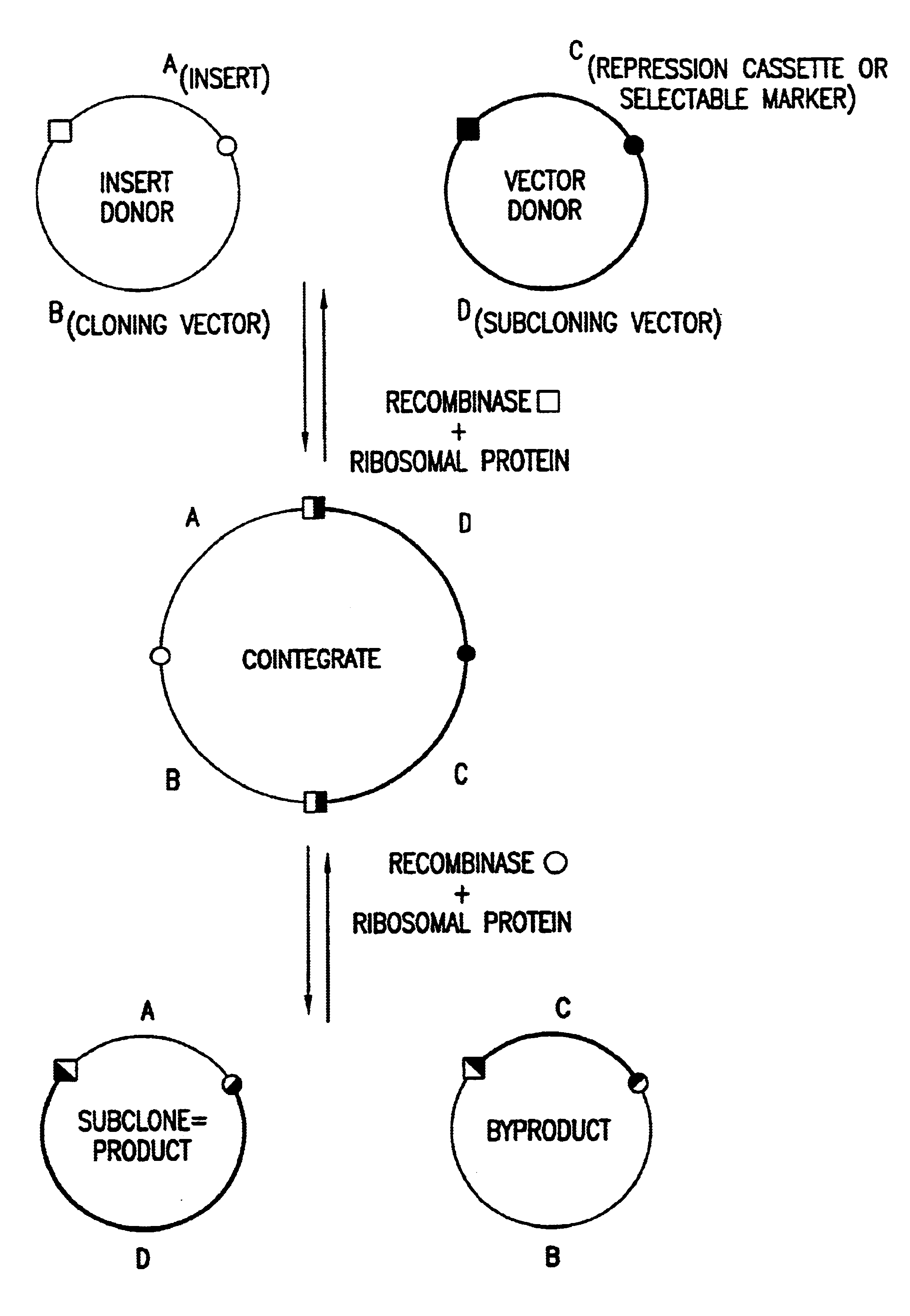Enhanced in vitro recombinational cloning of using ribosomal proteins
- Summary
- Abstract
- Description
- Claims
- Application Information
AI Technical Summary
Benefits of technology
Problems solved by technology
Method used
Image
Examples
example 1
Stimulation of Integrase by E. coli Ribosomal Proteins
Materials and Methods
[0234]DNAs for Recombination Assays
[0235]Plasmid pHN894 (FIG. 2), bearing an attP site, and plasmid pBB105 (FIG. 3), bearing an attB site, are described (Kitts, P. A. and Nash, H. A. J. Mol. Biol. 204: 95-107 (1988); Nash, H. A. Methods Enz. 100: 210-216 (1983)). pBB105 was cut with EcoRI before use. Plasmid pHN872 (FIG. 4), bearing an attL site, and plasmid pHN868 (FIG. 5), bearing an attR site, are described (Kitts, P. A. and Nash, H. A. J. Mol. Biol. 204:95-107 (1988)). pHN872 was cut with SalI before use. These plasmids were propagated in E. coli strain DH10B. To grow cells for preparation of plasmid DNA, the growth medium contained in one liter: 12 g of tryptone, 24 g of yeast extract, 2.3 g of KH2PO4, 12.5 g of K2HPO4, 0.01% (v / v) PPG antifoam, and appropriate antibiotic. Cells from a glycerol seed were placed in 25 ml of medium containing 100 μg / ml ampicillin (pBB105, pHN894, pHN868) or 100 μg / ml kanam...
example 2
Stimulation of Integrase Recombination by other E. coli Ribosomal Proteins
[0316]In addition to S20 and L27, other E. coli ribosomal proteins may stimulate the activity of recombination systems, particularly the 1 Int system. In particular, E. coli ribosomal proteins that are basic and are about 14 kilodaltons or less in size are used to stimulate the activity of prokaryotic recombination systems. Such ribosomal proteins that may be used are shown in Table 5:
[0317]
TABLE 5Additional Ribosomal Proteins for Use in StimulatingRecombination ActivityMolecularRibosomalNo. of Basic ResiduesNo. of TotalWeightProtein(% of Total)Residues(Daltons)S1017 (16.5%)10311,736S1423 (23.7%)9711,063S1516 (18.4%)8710,001S1614 (17.1%)829,191S1716 (19.3%)839,573S1817 (23.0%)748,896S1919 (20.9%)9110,299S2123 (32.9%)708,369L2117 (16.5%)10311,565L2321 (21.2%)9911,013L2422 (21.4%)10311,185L2517 (18.1%)9410,694L2818 (23.4%)778,875L2912 (19.0%)637,274L3010 (17.2%)586,411L3112 (19.4%)626,971L3211 (19.6%)566,315L331...
PUM
| Property | Measurement | Unit |
|---|---|---|
| Atomic weight | aaaaa | aaaaa |
| Mass | aaaaa | aaaaa |
| Mass | aaaaa | aaaaa |
Abstract
Description
Claims
Application Information
 Login to View More
Login to View More - R&D
- Intellectual Property
- Life Sciences
- Materials
- Tech Scout
- Unparalleled Data Quality
- Higher Quality Content
- 60% Fewer Hallucinations
Browse by: Latest US Patents, China's latest patents, Technical Efficacy Thesaurus, Application Domain, Technology Topic, Popular Technical Reports.
© 2025 PatSnap. All rights reserved.Legal|Privacy policy|Modern Slavery Act Transparency Statement|Sitemap|About US| Contact US: help@patsnap.com



